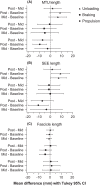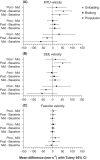Altered countermovement jump force profile and muscle-tendon unit kinematics following combined ballistic training
- PMID: 35844051
- PMCID: PMC9544266
- DOI: 10.1111/sms.14211
Altered countermovement jump force profile and muscle-tendon unit kinematics following combined ballistic training
Erratum in
-
Corrigendum to "Altered countermovement jump force profile and muscle-tendon unit kinematics following combined ballistic training".Scand J Med Sci Sports. 2023 Jul;33(7):1262-1268. doi: 10.1111/sms.14381. Epub 2023 May 17. Scand J Med Sci Sports. 2023. PMID: 37194728 Free PMC article. No abstract available.
Abstract
Combined heavy- and light-load ballistic training is often employed in high-performance sport to improve athletic performance and is accompanied by adaptations in muscle architecture. However, little is known about how training affects muscle-tendon unit (MTU) kinematics during the execution of a sport-specific skill (e.g., jumping), which could improve our understanding of how training improves athletic performance. The aim of this study was to investigate vastus lateralis (VL) MTU kinematics during a countermovement jump (CMJ) following combined ballistic training. Eighteen young, healthy males completed a 10-week program consisting of weightlifting derivatives, plyometrics, and ballistic tasks under a range of loads. Ultrasonography of VL and force plate measurements during a CMJ were taken at baseline, mid-test, and post-test. The training program improved CMJ height by 11 ± 13%. During the CMJ, VL's MTU and series elastic element (SEE) length changes and velocities increased from baseline to post-test, but VL's fascicle length change and velocity did not significantly change. It is speculated that altered lower limb coordination and increased force output of the lower limb muscles during the CMJ allowed more energy to be stored within VL's SEE. This may have contributed to enhanced VL MTU work during the propulsion phase and an improved CMJ performance following combined ballistic training.
Keywords: Ultrasonography; muscle mechanics; performance; resistance exercise; weightlifting.
© 2022 The Authors. Scandinavian Journal of Medicine & Science In Sports published by John Wiley & Sons Ltd.
Conflict of interest statement
The authors wish to disclose that there are no professional relationships with companies or manufacturers that could benefit from the results of the present study. The results of the study are presented clearly, honestly, and without fabrication, falsification, or inappropriate data manipulation.
Figures





Similar articles
-
Acute Effects of Static and Ballistic Stretching on Muscle-Tendon Unit Stiffness, Work Absorption, Strength, Power, and Vertical Jump Performance.J Strength Cond Res. 2022 Aug 1;36(8):2147-2155. doi: 10.1519/JSC.0000000000003894. Epub 2020 Nov 16. J Strength Cond Res. 2022. PMID: 33201157
-
Influence of muscle-tendon unit structure on rate of force development during the squat, countermovement, and drop jumps.J Strength Cond Res. 2011 Feb;25(2):340-7. doi: 10.1519/jsc.0b013e3182052d78. J Strength Cond Res. 2011. PMID: 21322836
-
Lower-body muscle structure and its role in jump performance during squat, countermovement, and depth drop jumps.J Strength Cond Res. 2010 Mar;24(3):722-9. doi: 10.1519/JSC.0b013e3181d32c04. J Strength Cond Res. 2010. PMID: 20195084
-
Unique aspects of competitive weightlifting: performance, training and physiology.Sports Med. 2012 Sep 1;42(9):769-90. doi: 10.1007/BF03262294. Sports Med. 2012. PMID: 22873835 Review.
-
The Difference Between Countermovement and Squat Jump Performances: A Review of Underlying Mechanisms With Practical Applications.J Strength Cond Res. 2017 Jul;31(7):2011-2020. doi: 10.1519/JSC.0000000000001913. J Strength Cond Res. 2017. PMID: 28640774 Review.
Cited by
-
Decoupling of muscle-tendon unit and fascicle velocity contributes to the in vivo stretch-shortening cycle effect in the male human triceps surae muscle.Physiol Rep. 2024 Dec;12(23):e70131. doi: 10.14814/phy2.70131. Physiol Rep. 2024. PMID: 39663152 Free PMC article.
-
Joint Coordination and Muscle-Tendon Interaction Differ Depending on The Level of Jumping Performance.J Sports Sci Med. 2023 Jun 1;22(2):189-195. doi: 10.52082/jssm.2023.189. eCollection 2023 Jun. J Sports Sci Med. 2023. PMID: 37293413 Free PMC article.
-
Optimizing Resistance Training for Sprint and Endurance Athletes: Balancing Positive and Negative Adaptations.Sports Med. 2024 Dec;54(12):3019-3050. doi: 10.1007/s40279-024-02110-4. Epub 2024 Oct 7. Sports Med. 2024. PMID: 39373864 Free PMC article. Review.
-
Muscle Architectural and Force-Velocity Curve Adaptations following 10 Weeks of Training with Weightlifting Catching and Pulling Derivatives.J Sports Sci Med. 2022 Dec 1;21(4):504-516. doi: 10.52082/jssm.2022.504. eCollection 2022 Dec. J Sports Sci Med. 2022. PMID: 36523888 Free PMC article. Clinical Trial.
-
Caffeine's influence on vertical jump height: a real-life collegiate student-athlete approach.J Int Soc Sports Nutr. 2025 Dec;22(1):2501063. doi: 10.1080/15502783.2025.2501063. Epub 2025 May 4. J Int Soc Sports Nutr. 2025. PMID: 40320739 Free PMC article. Clinical Trial.
References
-
- Hill AV. The heat of shortening and the dynamic constants of muscle. Proc R Soc B Biol Sci. 1938;126(843):136‐195. doi:10.1098/rspb.1938.0050 - DOI
MeSH terms
LinkOut - more resources
Full Text Sources

